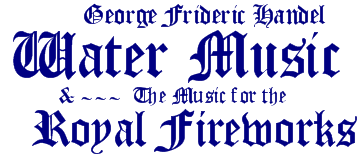 |
Summer evokes outdoor concerts, but the music often gets trumped by the occasion – we recall the atmosphere, logistics and companions more than the actual entertainment. but the music often gets trumped by the occasion – we recall the atmosphere, logistics and companions more than the actual entertainment.  Two of the most renown were presented in London a dozen generations ago by George Frideric Handel, whose music has survived to delight modern audiences. Two of the most renown were presented in London a dozen generations ago by George Frideric Handel, whose music has survived to delight modern audiences.
The first took place on April 17, 1717. The Daily Courant reported:
At about 8, the King took Water at Whitehall in an open Barge ... and went up the [Thames] River towards Chelsea. Many other Barges with Persons of Quality attended, and so great a Number of Boats, that the whole River in a manner was cover'd; a City Company's Barge was employ'd for the Musick, wherein were 50 instruments of all sorts, who play'd all the Way from Lambeth the finest Symphonies, compos'd express for this Occasion, by Mr. Hendel; which his Majesty liked so well, that he caus'd it to be plaid over three times in going and returning. At Eleven his Majesty went a-shore at Chelsea where a Supper was prepar'd, and then there was another very fine Consort of Musick, which lasted till 2; after which, his Majesty came again into his Barge, and return'd the same Way, the Musick continuing to play till he landed.
The Prussian ambassador,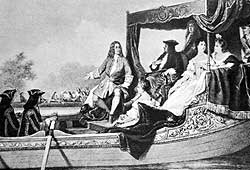 Friedrich Bonet, corroborated the newspaper account and provided further details of the "Musick" – it was sponsored by a Baron Kilmanseck, the instruments consisted of trumpets, horns, oboes, bassoons, flutes, violins and basses, and each of the three performances lasted an hour – twice going and again returning. Friedrich Bonet, corroborated the newspaper account and provided further details of the "Musick" – it was sponsored by a Baron Kilmanseck, the instruments consisted of trumpets, horns, oboes, bassoons, flutes, violins and basses, and each of the three performances lasted an hour – twice going and again returning.
Unfortunately, though, we have no reliable documentation of just what was played. Although many of the pieces became instant hits throughout London, none was published at the time. The chronology has been traced by Roger Fiske in his preface to the Eulenburg score. Two of the minuets appeared in 1720, followed by the overture in 1725. John Walsh published The Celebrated Water Musick in 1733, but with only eleven of the nineteen movements that he included in a 1743 harpsichord arrangement as Handel's Celebrated Water Musick Compleat. Up to a dozen other selections, including an entire five-movement 1733 Famous Water Peice, once were claimed to be part of the work but later rejected as spurious.  Extensive research by Samuel Arnold led to a 1788 edition of nineteen pieces that is generally accepted as the authoritative Water Music. Yet, questions of structure remain. Extensive research by Samuel Arnold led to a 1788 edition of nineteen pieces that is generally accepted as the authoritative Water Music. Yet, questions of structure remain.
While some arrangers try to separate the dances with more reflective interludes, most nowadays tend to group the pieces into three suites of distinctive character. The first, in F major/d minor, features French horns (possibly their first use in England); the second, in D, adds trumpets; and the third, in G, is more lightly scored with flutes. Scholars now tend to speculate that the suite in F, the longest and widest-ranging, was played on the outbound trip (and may have been written for a similar excursion two years earlier); the third, too delicate for outdoors, during the banquet; and the noble second during the concluding downstream trip back home. (But this conflicts with Bonet's claims that the entire set was played each time and that each performance took an hour - even with pauses for the musicians to catch their breath, the first suite is barely half that long; yet the movements may have been repeated or perhaps Handel, a notorious recycler, may have enlarged the work with other pieces.)
Then as now, a success demands a sequel. That occasion was the mammoth festivities planned for April 27, 1749 to celebrate the treaty of Aix-la-Chapelle that ended the War of Austrian Succession. Fireworks were to erupt from a massive "machine," an elaborately decorated wooden Dorian temple, 410 feet long and 114 feet high, constructed in Green Park. According to an observer, Horace Walpole:
For a week before, the town was like a country fair, the streets filled from morning to night, scaffolds building wherever you could or could not see, and coaches arriving from every corner of the kingdom.
To defuse the tension, 12,000 tickets were sold for a rehearsal of Handel's music, which ended with a 101 cannon salute and caused a massive traffic jam that blocked London Bridge for three hours.
The event itself was a sensation, but quite not as planned. 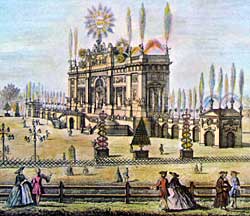
The "Machine" before the concert ... |
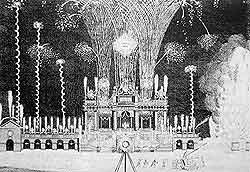
... and during (with fire brigade) |
Reportedly, the night was rainy, many fireworks fizzled and ground displays failed to ignite. One Horace Walpole observed: "The wheels and all that was to compose the principal part were pitiful and ill-conducted, with no change of colored fire and shapes; the illumination was mean, and lighted so slowly that scarce anybody had patience to wait the finishing." However, there was a grand finale – the "machine" itself caught fire and burned to the ground! (A contemporary illustration [at right] was captioned: "The GRAND WHIM for Posterity to Laugh At ... with the Right Wing on Fire and the cutting away the two Middle Arches to prevent the whole Fabrick from being Deftroy'd.") A stampede ensued but, according to Walpole: "Very little mischief was done, and but two persons killed."
None of the surviving reports made any mention at all of Handel's music, and so the extent to which it meshed with the fireworks is not known. Fortunately, though, we do have his autograph score. The King at first wanted no music but compromised by decreeing only "martial instruments." Handel, too, bargained – for sufficient volume to be heard over the din he had wanted a hundred players, but settled for the then-colossal ensemble of 24 oboes, 12 bassoons, 9 horns, 9 trumpets and 3 kettledrums.  Yet, he did have the final say - despite the royal aversion, Handel added strings to his score for a repeat performance the next month to benefit his favorite charity, the Foundling Hospital. Yet, he did have the final say - despite the royal aversion, Handel added strings to his score for a repeat performance the next month to benefit his favorite charity, the Foundling Hospital.
The huge crowds for both the Water Music and Fireworks performances are significant. Public concerts would arise only in the late 18th century. Before then, performances of opera, concerti and all the other secular Baroque works we now revere were strictly for royalty and their entourages. The general public had no access aside from trickle-down versions by itinerant musicians, and 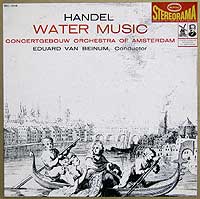 indeed, many would pass their entire lives without ever hearing a skilled artist perform great music. An opportunity to witness a brand new work by England's most famous composer was unique and not to be missed. indeed, many would pass their entire lives without ever hearing a skilled artist perform great music. An opportunity to witness a brand new work by England's most famous composer was unique and not to be missed.
Perhaps well aware of this, Handel seized the occasions not only to delight his unaccustomed fans, but, more important, to educate them. Both the Water Music and Royal Fireworks brought his audience a crash course in the art they had missed. Thus, Bernard Jacobson hails the Water Music as a glorious amalgam of styles, combining the Italian taste for contrast between solo and ensemble, English bass-writing and alluring French dance rhythms. H. C. Robbins Landon viewed the result as one of diplomacy, essentially appealing to the English audience while incorporating a cosmopolitan range of influences from a formal overture, minuets and pastoral airs, to a sailors' hornpipe and a rollicking country dance.
Handel was ideally situated to this role. Although he settled in England (and became a British citizen in 1724),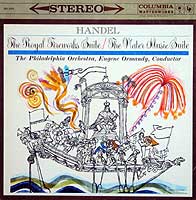 he was raised in Germany and trained in Italy, and so combined all but one of the European powerhouses of culture. While his gift for alluring melody and colorful orchestration gave his instrumental music wide appeal, it was used primarily as interludes in the theatre, for which he had a particular affinity. At first, the power and emotion of his Italianate operas created a sensation, and then, after taste had shifted, he launched an even greater career with Biblical oratorios; the tradition of annual performances of his most famous, the Messiah, persists to this day. he was raised in Germany and trained in Italy, and so combined all but one of the European powerhouses of culture. While his gift for alluring melody and colorful orchestration gave his instrumental music wide appeal, it was used primarily as interludes in the theatre, for which he had a particular affinity. At first, the power and emotion of his Italianate operas created a sensation, and then, after taste had shifted, he launched an even greater career with Biblical oratorios; the tradition of annual performances of his most famous, the Messiah, persists to this day.
Yet, by the advent of recordings, Handel had fallen long out of favor, and both the Water Music and Fireworks became known largely in arrangements by Hamilton Harty that catered to late romantic taste – heavily abridged and densely orchestrated, with simplified rhythms, smoothed dynamics and underlined cadences. 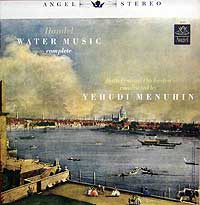 For a 1958 recording with his Philadelphia Orchestra, Eugene Ormandy provided a Water Music arrangement of his own with a far lighter hand. Yet, even these served a crucial purpose – to introduce Handel to audiences otherwise inclined to dismiss him as an archaic historical footnote. For a 1958 recording with his Philadelphia Orchestra, Eugene Ormandy provided a Water Music arrangement of his own with a far lighter hand. Yet, even these served a crucial purpose – to introduce Handel to audiences otherwise inclined to dismiss him as an archaic historical footnote.
The advent of stereo stirred interest in the complete Water Music. Edward van Beinum and the Amsterdam Concertgebouw (Epic) are gracious and elegant, with exquisitely refined playing, Yehudi Menuhin and the Bath Festival Orchestra (EMI) choose a leaner sonority and a keener sense of period style, and Hermann Scherchen and the Vienna State Opera Orchestra (Westminster) are full of subtle balances and imaginative interpretive touches. 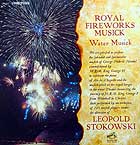 Leopold Stokowski used an augmented RCA Symphony Orchestra of 120 to invest the score with his trademark color but the result emerged as surprisingly moribund, the principal excitement coming during the last half-minute in which the Fireworks are ruined by ridiculous sound effects of explosions and screaming crowds. Leopold Stokowski used an augmented RCA Symphony Orchestra of 120 to invest the score with his trademark color but the result emerged as surprisingly moribund, the principal excitement coming during the last half-minute in which the Fireworks are ruined by ridiculous sound effects of explosions and screaming crowds.
The many fine performances currently available divide into those on modern and period instruments. Among the former are acclaimed readings by Raymond Leppard and the English Chamber Orchestra (Philips), Neville Mariner and the Academy of St. Martin-in-the-Fields (Decca), Gerard Schwartz and the Los Angeles Chamber Orchestra (Delos), and Orpheus (DG). The latter achieves a clean, tight ensemble without a conductor, its intimacy emerging wholly from within. (The oft-admired New York Philharmonic recording with Pierre Boulez (Sony) is precise but sleepy, drained of the spirit of his 1960s Nonesuch LP with the Hague Philharmonic.) 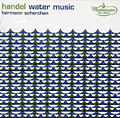 All convey the timeless grandeur and brilliance of this music, its humanity nestled in formality. Yet, even the best of these sound somewhat bland compared to those that embrace the distinctive sonorities and balances of Handel's time. All convey the timeless grandeur and brilliance of this music, its humanity nestled in formality. Yet, even the best of these sound somewhat bland compared to those that embrace the distinctive sonorities and balances of Handel's time.
The proud parade 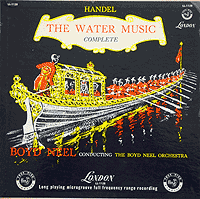 of historically significant recordings had been launched in a 1954 album by Boyd Neel and The Boyd Neel Orchestra (London LP). A physician enamoured of music, Neel had formed his own 18-piece string orchestra in London in 1933. Two decades later, their record appears to have been the first of the complete Water Music on a major label. Although using modern instruments (plus a harpsichord), the lean textures of their ensemble, infused with crisp, vivid playing and bounding with high spirits, paved the way to the historically-informed performances to which we have now become accustomed. The Neel recording remains as delightful today as it was hugely influential in its time. of historically significant recordings had been launched in a 1954 album by Boyd Neel and The Boyd Neel Orchestra (London LP). A physician enamoured of music, Neel had formed his own 18-piece string orchestra in London in 1933. Two decades later, their record appears to have been the first of the complete Water Music on a major label. Although using modern instruments (plus a harpsichord), the lean textures of their ensemble, infused with crisp, vivid playing and bounding with high spirits, paved the way to the historically-informed performances to which we have now become accustomed. The Neel recording remains as delightful today as it was hugely influential in its time.
But the Neel recording and all the others noted here were major label releases,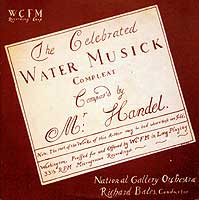 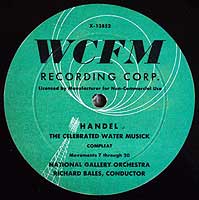 marketed and available for purchase world-wide. The true pioneer among Water Musics appears to have been an obscure 1950 LP issued by Washington, DC radio station WCFM on its own private label, featuring the National Gallery Orchestra conducted by Richard Bales, music director of the National Gallery of Art, who founded the ensemble in 1943 and reportedly led it in 1,700 free Sunday afternoon concerts of American music over 42 years. (They recorded three deluxe albums for Columbia – The American Revolution, The Confederacy and The Union, each featuring narration, essays and music of the eras.) The cover was a simple but effective announcement of the contents, which the notes carefully distinguished from the then-prevalent Harty suite. The ensemble plays with wonderful cohesion and warmth, solos are fully integrated into the overall texture, and tempos are dignified yet enthused. In an effort to suggest authentic balances, winds are pared and the harpsichord eliminated altogether. The quality of both performance and recording belies its inscription in a single session. marketed and available for purchase world-wide. The true pioneer among Water Musics appears to have been an obscure 1950 LP issued by Washington, DC radio station WCFM on its own private label, featuring the National Gallery Orchestra conducted by Richard Bales, music director of the National Gallery of Art, who founded the ensemble in 1943 and reportedly led it in 1,700 free Sunday afternoon concerts of American music over 42 years. (They recorded three deluxe albums for Columbia – The American Revolution, The Confederacy and The Union, each featuring narration, essays and music of the eras.) The cover was a simple but effective announcement of the contents, which the notes carefully distinguished from the then-prevalent Harty suite. The ensemble plays with wonderful cohesion and warmth, solos are fully integrated into the overall texture, and tempos are dignified yet enthused. In an effort to suggest authentic balances, winds are pared and the harpsichord eliminated altogether. The quality of both performance and recording belies its inscription in a single session.
Thurston Dart and the Philomusica of London (Oiseau-Lyre) introduced a chamber sonority. 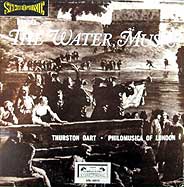 Curiously, though, while Dart authored a seminal 1954 study of early performance practices (The Interpretation of Music), his reading was full of modern vibrato and stopped short of applying his scholarly research to restore elements of 18th century style that Handel never bothered to write out, since he had assumed his players understood them. Foremost among these is an exaggeration of the difference between dotted and short notes. Curiously, though, while Dart authored a seminal 1954 study of early performance practices (The Interpretation of Music), his reading was full of modern vibrato and stopped short of applying his scholarly research to restore elements of 18th century style that Handel never bothered to write out, since he had assumed his players understood them. Foremost among these is an exaggeration of the difference between dotted and short notes.  Indeed, a clear sign of observing baroque conventions comes at the very outset of both works. Thus, while the opening rhythm of the Fireworks overture is written as a dotted quarter note followed by an eighth note, the practice in Handel's time was to assume double-dotting, as if the first note were 1� beats followed by a sixteenth note. (The authoritative Eulenburg score shows both the original notation and a set of extra flags denoting the preferred rhythm.) Indeed, a clear sign of observing baroque conventions comes at the very outset of both works. Thus, while the opening rhythm of the Fireworks overture is written as a dotted quarter note followed by an eighth note, the practice in Handel's time was to assume double-dotting, as if the first note were 1� beats followed by a sixteenth note. (The authoritative Eulenburg score shows both the original notation and a set of extra flags denoting the preferred rhythm.)
A 1978 recording by Nikolaus Harnoncourt (Das Alte Werk) launched the original instrument revival of Handel. 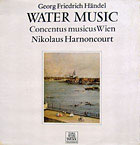 Playing mostly instruments from Handel's time (plus a few authentic copies), the 27-member Concentus Musicus Wien zipped through the whole work in 43 minutes, with breakneck tempos, lean textures and startling sonorities, including horn trills that shock with their virtuostic attacks (no easy feat using "natural" horns without any valves, so that all tonal effects are done through the lips). Yet, despite its visceral thrill, the impact may lack suitable style – this music was meant to enchant conservative nobility during a relaxing excursion, not to blow their boat out of the water. Playing mostly instruments from Handel's time (plus a few authentic copies), the 27-member Concentus Musicus Wien zipped through the whole work in 43 minutes, with breakneck tempos, lean textures and startling sonorities, including horn trills that shock with their virtuostic attacks (no easy feat using "natural" horns without any valves, so that all tonal effects are done through the lips). Yet, despite its visceral thrill, the impact may lack suitable style – this music was meant to enchant conservative nobility during a relaxing excursion, not to blow their boat out of the water.
Actually, an obscure yet faithful recording of the Fireworks had appeared a decade earlier on a Vox LP from the Telemann Society Band led by Richard Schulze and featuring valveless hunting horns and trumpets, oboes and bassoons with thick French reeds and a leather cavalry serpent, a six-foot winding leather contraption to provide the bass. As explained in an accompanying audio demonstration comparing period instruments with their modern counterparts, the overtones produced by natural tuning (in the days before the tyranny of keyboard-mandated "equal temperament," when a c-sharp and a d-flat were quite different, neither half-way between C and D) tend to clash and sound "radical" to modern ears. It does indeed – the sour intonation (and the rhythmic insecurity from the sheer effort needed to coax sound out of these instruments) evoke more the aura of a grade-school band rehearsal than an enjoyable concert. oboes and bassoons with thick French reeds and a leather cavalry serpent, a six-foot winding leather contraption to provide the bass. As explained in an accompanying audio demonstration comparing period instruments with their modern counterparts, the overtones produced by natural tuning (in the days before the tyranny of keyboard-mandated "equal temperament," when a c-sharp and a d-flat were quite different, neither half-way between C and D) tend to clash and sound "radical" to modern ears. It does indeed – the sour intonation (and the rhythmic insecurity from the sheer effort needed to coax sound out of these instruments) evoke more the aura of a grade-school band rehearsal than an enjoyable concert.
Modern recordings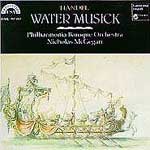 boasting period instruments and embellishments include Christopher Hogwood and the Academy of Ancient Music (Oiseau-Lyre), the Linde Consort (Virgin), Martin Pearlman and the Boston Baroque (Telarc), Jeanne Lamon and Tafelmusik (Sony) and Trevor Pinnock and the English Concert (Archiv). All feature lucid tempos, bright sonority, careful balances and superb playing. Standouts are Nicholas McGegan and the Philharmonic Baroque Orchestra (Harmonia Mundi) and Jordi Saval and Le Concert des Nations (Astr�e) – both are especially peppy and alert, brimming with spirit, constantly shifting timbres, intensified pacing and irresistibly vivid dances. boasting period instruments and embellishments include Christopher Hogwood and the Academy of Ancient Music (Oiseau-Lyre), the Linde Consort (Virgin), Martin Pearlman and the Boston Baroque (Telarc), Jeanne Lamon and Tafelmusik (Sony) and Trevor Pinnock and the English Concert (Archiv). All feature lucid tempos, bright sonority, careful balances and superb playing. Standouts are Nicholas McGegan and the Philharmonic Baroque Orchestra (Harmonia Mundi) and Jordi Saval and Le Concert des Nations (Astr�e) – both are especially peppy and alert, brimming with spirit, constantly shifting timbres, intensified pacing and irresistibly vivid dances.
Yet, authenticity for these works is an elusive concept, considering their conception and purpose. 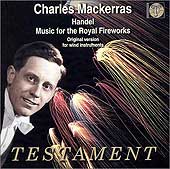 In the days before electronic amplification, the challenges of hearing an outdoor performance were severe enough, but were considerably worsened in the middle of a river or amid vast crowds, without the natural acoustical reinforcement of a band-shell or amphitheatre. Three recordings tackle the problem creatively with enhanced musical forces. A pioneering 1959 Fireworks by Charles Mackerras (now on a Testament CD) massed 64 London wind and brass players to replicate the needed volume to be heard on that occasion; although tempos are stodgy, In the days before electronic amplification, the challenges of hearing an outdoor performance were severe enough, but were considerably worsened in the middle of a river or amid vast crowds, without the natural acoustical reinforcement of a band-shell or amphitheatre. Three recordings tackle the problem creatively with enhanced musical forces. A pioneering 1959 Fireworks by Charles Mackerras (now on a Testament CD) massed 64 London wind and brass players to replicate the needed volume to be heard on that occasion; although tempos are stodgy,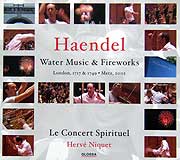 it still seems a far more reliable guide to the original sound than all the period versions noted above that feature a prominent harpsichord continuo (which, while rarely notated but assumed to be intended in nearly all Handel's other music, could not possibly have been heard in an open outdoor setting). The feat was repeated in 1972 by Johannes Somary and an augmented English Chamber Orchestra; while interpretively bland, the SQ quadraphonic system invoked not only the original scoring but its spatial ambience (excitingly conveyed on a Vanguard 4-channel SACD). Among modern recordings, only one follows boldly in Mackerras's footsteps (although it adds the strings that most likely were absent the first night) – Le Concert Spirituel, led by Herv� Niquet (2002, Glossa), an ecstatic romp with pounding tympani, added fanfares and a half-minute drum solo that fairly bursts with the unfettered spirit of an outdoor celebration. It's rowdy to be sure, but a palpable reflection of the ecstatic excitement of a crowd who had never before heard such a splendid outpouring of glorious sound. it still seems a far more reliable guide to the original sound than all the period versions noted above that feature a prominent harpsichord continuo (which, while rarely notated but assumed to be intended in nearly all Handel's other music, could not possibly have been heard in an open outdoor setting). The feat was repeated in 1972 by Johannes Somary and an augmented English Chamber Orchestra; while interpretively bland, the SQ quadraphonic system invoked not only the original scoring but its spatial ambience (excitingly conveyed on a Vanguard 4-channel SACD). Among modern recordings, only one follows boldly in Mackerras's footsteps (although it adds the strings that most likely were absent the first night) – Le Concert Spirituel, led by Herv� Niquet (2002, Glossa), an ecstatic romp with pounding tympani, added fanfares and a half-minute drum solo that fairly bursts with the unfettered spirit of an outdoor celebration. It's rowdy to be sure, but a palpable reflection of the ecstatic excitement of a crowd who had never before heard such a splendid outpouring of glorious sound.
Among the many Handel biographies, H. C. Robbins Landon's Handel and His World (Little Brown, 1984) relies mostly on contemporaneous documents, is heavily illustrated, contains an annotated bibliography,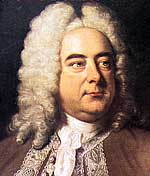 and devotes full chapters to the Water Music and Royal Fireworks (which most others tend to slight in favor of the more influential operas, oratorios and concertos). Among the sources from which Landon quotes extensively is the very first Handel biography, John Mainwaring's 1760 Memoirs of the Life of the Late George Frederic Handel, which preserves recollections of Handel's family and associates but also launched some erroneous and persistent claims. Chief among these is the oft-repeated account of the origin of the Water Music. Handel had been appointed Kappelmeister to the German Hanover court, but his patron had become upset that the court composer was constantly absent on extended English stays. According to Mainwaring, when the Hanover Elector succeeded to the English throne in 1714, he snubbed Handel, who made amends by surprising the king on a 1715 rafting party with a concert at which he presented his Water Music (or at least the first portion that now comprises the suite in F, later adapted for the 1717 festivities). That's now largely discredited, as whatever rift there had been with his former employer and current sovereign Handel had healed long before. Even so, it's a charming and harmless tale. and devotes full chapters to the Water Music and Royal Fireworks (which most others tend to slight in favor of the more influential operas, oratorios and concertos). Among the sources from which Landon quotes extensively is the very first Handel biography, John Mainwaring's 1760 Memoirs of the Life of the Late George Frederic Handel, which preserves recollections of Handel's family and associates but also launched some erroneous and persistent claims. Chief among these is the oft-repeated account of the origin of the Water Music. Handel had been appointed Kappelmeister to the German Hanover court, but his patron had become upset that the court composer was constantly absent on extended English stays. According to Mainwaring, when the Hanover Elector succeeded to the English throne in 1714, he snubbed Handel, who made amends by surprising the king on a 1715 rafting party with a concert at which he presented his Water Music (or at least the first portion that now comprises the suite in F, later adapted for the 1717 festivities). That's now largely discredited, as whatever rift there had been with his former employer and current sovereign Handel had healed long before. Even so, it's a charming and harmless tale.

Copyright 2005 by Peter Gutmann
|
